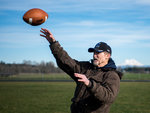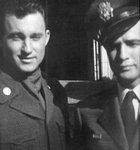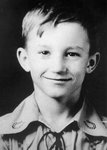


Editor’s Note: This is Part One of a three-part series focused on the Life of Adna resident Warren Robertson. Look for the next installment in Saturday’s edition and online at www.chronline.com.
In the 1930s, a young Texas boy had been handed a death sentence.
With his hometown of Archer City, his family and the rest of the country still reeling from the cold, tight grips of the Great Depression, it seemed that any measure of success — or even a future — had been snatched away before the boy could even contemplate his potential.
Warren Robertson, incapacitated by a severe case of rheumatic fever, was a child forced to grapple with the terrible realities of death at an age when he should have been still learning about the joys of life.
“It erased me,” Robertson said. “I wasn’t supposed to live.”
He spent months all but immobile, intense pain coursing through his young frame. He wouldn’t lead a normal life, he was told. He wouldn’t be able to play football, a revered rite of passage in the Longhorn State, nor would he be able to taste other sweet fruits of adolescence.
He wondered if some childhood sin had brought the wrath of God upon him, if there was something he’d done that had placed him in the predicament. It was a mindstate created by a religious upbringing at the hands of his mother, a kind and vivacious woman who struggled with bipolar disorder, and a father who had seen his own future snatched away by the historic financial crisis.
They wanted the best for Warren and his brother, but Warren had instead found the worst.
Dark thoughts addled Robertson’s mind, but they never destroyed it.
Then, something unexpected happened.
He lived.
Against the medical odds placed on his very being, Robertson recovered from his physical ailment without any lasting disabilities.
Ultimately, the child of the Great Depression rode a wave of fate, serendipity and success into the world, where he would cement his legacy as a celebrated acting coach, innovator and titan of the entertainment industry.
His adventures included a case of mistaken identity that led to a slot on the roster of a U.S. military football team in Japan, a chance encounter with film legend Marlon Brando and an eventual tenure at The Actor’s Studio, where he rubbed shoulders with Paul Newman, James Deen, Peter Falk and Marilyn Monroe.
It all culminated in a celebrated career as an acting coach during which he helped form the careers of household names such as Patrick Swayze, Dolph Lundgren and Viggo Mortensen, to name a random few.
He owned theaters and shaped professions from New York City to Vancouver, B.C., and all points in between and abroad.
“I don’t think I really started understanding at all what it meant to be an actor — to go down in your inside and come up with stuff that you should have a license to mess with — until later in New York when I was studying with Warren Robertson, who started getting me to understand what ‘organic’ really meant and looked like,” Swayze once told a reporter.
The late lead man’s praise for Robertson is not isolated.
The entertainment industry, past and present, is riddled with similar statements from stars noting his ability to get past young actors’ fears and circumnavigate the certainty and overconfidence of trained stage professionals.
Robertson became an icon in the world of method acting, studying under Lee Strasberg and Stella Adler, two names that defined the style in America.
Before exploring that wild past, though, it’s important to understand the present.
Today, Robertson resides on a quiet parcel along Bunker Creek Road outside Adna with his partner of 22 years, Kelle Kleingartner.
Impossibly youthful considering his 85 years traveling the Earth, he remains fluid in his movements and active with his time, whether he’s chasing down an escaped horse or kicking field goals and playing catch with a pair of journalists stunned by his athleticism.
Of all his activity, though, you’re not likely to find him talking much about his star-studded past.
His life is a quiet one now, not unlike his early days in Archer City, before his health was temporarily snatched away.
Today, there’s another similarity to those years in East Texas.
He’s living his golden years in the shadow of yet another ailment, a heart that was supposed to give out long ago, at least according to doctors.
He’s lived with the diagnosis for decades, and he wasn’t expected to live as long as he has.
His continued survival, though, is less surprising within the context of a life story that defies simple narration.
“It’s like the Odyssey,” Robertson says.
If you take the Greek epic poem attributed to Homer as the starting framework, then one leg of Robertson’s perilous journey certainly began here in Washington.
It happened at what is now Joint Base Lewis-McChord on dreary day in 1954 that was made all the more depressing for the fact that hundreds of young men were being herded like cattle toward military conflict — the Korean War, specifically.
“It was still a shooting war at that point,” Robertson recalls.
One moment, Robertson was working to finish a psychology degree at the University of Texas. Suddenly, he was drafted into the U.S. Army.
He was set to be suited up and flown out to East Asia where he would risk becoming one of more than 50,000 American casualties in the bloody affair.
Fate had other plans.
While being processed at the military base, he was abruptly plucked out of line by a superior officer.
He knew better than to protest as he was quickly moved to another area of the sprawling facility.
“My uncle told me never to question them,” Robertson said of heeding orders from his military masters.
So he didn’t.
As he recalls, he was quiet as he was separated from other draftees and placed in a bunk with a behemoth of a man who truly fit the picture of an All-American football player, a designation that equalled royalty in the Texas town he had left behind.
Before he knew it, he was being shipped off to the Far East.
Eventually, he learned he had been mistaken for George Robinson, another Texan who had truly earned All-American status. The hulking presence who traveled with him was All-American Art Hunter, who would go on to play 12 seasons in the NFL. The two men never spoke on the journey.
He wouldn't learn his traveling partner’s identity — or the reason he had been snatched out of line — until he arrived in Japan, where for 18 months he lived the life of a football player while avoiding combat in Korea.
He thought perhaps he’d been chosen for the Honor Guard.
A military official who picked them up at an Air Force base cleared the questions.
He remarked on Hunter’s storied college career, and then turned to Robertson.
“I haven’t had a chance to see you play,” he said to Robertson. “But you must be fast as hell.”
Robertson was struck with panic.
“I had terrors and panics that I would be found,” he said.
His clothes were soaked with sweat.
“This is hell,” he recalls thinking.
“I said, ‘What will the Army do to me?’ They’ll never say ‘this was our mistake.’”
A September 1963 issue of Sports Illustrated tells the rest of the story best.
Written in Robertson’s own words, it details the fear and trepidation he experienced while touring the football field, seeing his teammates and being introduced to his new barracks upon arriving in Japan.
He was Warren Robertson when he looked in the mirror.
For all others who looked upon him, though, he was All-American George Robinson.
“The fact that I was Roberston, Warren, seemed not to make a bit of difference,” he wrote in Sports Illustrated. “I was here, so I had to be a football player, and I was ‘Robbie’ from there on in.”
Being “Robbie” meant playing an inherently violent sport with men more physically suited for the challenge.
Being “Robbie” meant being a running back, the one position that consistently demands one hurl his body in the direction of ill-meaning athletes again and again.
This was a man who had once been deemed physically unfit for the sport due to an illness he’d eventually conquer.
This, too, required Robertson to overcome the odds, and he rose to the challenge.
At practice, Robertson would occupy his time — and continue to cloak his identity — by running endless laps around the field, only stopping to pant “getting in shape” each time he passed a coach.
It was perhaps this method of preoccupation that earned him the admiration of his coaches, who soon had him donned in the green jersey indicative of a starting player.
He found himself in the backfield, scared beyond what many can effectively fathom.
“When the ball was snapped to the quarterback, I just aimed at that target, shut my eyes and ran,” he said. “About three feet forward, I felt something slap me in the pit of my stomach. I had no choice but to grab my arms to my midsection. And to my amazement, I was locked around the football, still going forward. I must have advanced eight or ten yards before I fell headlong over a prone body on the ground. That was the longest distance I had ever run with my eyes closed.”
Confidence would come, but not before a series of missteps and an odd style rightfully befitting a man who had never played football beyond the high school level.
None of it mattered.
He was Robbie, after all, and despite his hidden lack of experience, he was somehow adequately portraying an athlete worthy of his position.
“They wouldn't allow me to be less than the football player they thought I was,” he said.
In a glorious bit of foreshadowing, Robertson was an incredibly athletic actor.
He convinced everyone of their own assumptions, that he was an All-American star of the gridiron. He did so without speaking a falsehood.
If the story ended there, with Robertson returning to the United States to live a quiet life in a normal occupation, it would still be incredible.
It didn’t end there, though.
Robertson’s story had just begun.
•••
Look for Part Two of Warren Robertson’s story in Saturday’s edition of The Chronicle and online at www.chronline.com.